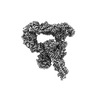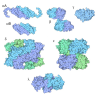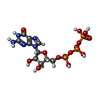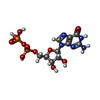+ Open data
Open data
- Basic information
Basic information
| Entry |  | |||||||||
|---|---|---|---|---|---|---|---|---|---|---|
| Title | Composite cryo-EM map of the Raptor-TFEB-Rag-Ragulator complex | |||||||||
 Map data Map data | A composite map of the Raptor-TFEB-Rag-Ragulator complex | |||||||||
 Sample Sample |
| |||||||||
 Keywords Keywords | mTORC1 / TFEB / Lysosome biogenesis / Autophagy / SIGNALING PROTEIN | |||||||||
| Function / homology |  Function and homology information Function and homology informationregulation of cholesterol import / positive regulation of protein localization to lysosome / regulation of cell-substrate junction organization / regulation of cholesterol efflux / Gtr1-Gtr2 GTPase complex / FNIP-folliculin RagC/D GAP / Ragulator complex / protein localization to cell junction / positive regulation of pentose-phosphate shunt / antibacterial innate immune response ...regulation of cholesterol import / positive regulation of protein localization to lysosome / regulation of cell-substrate junction organization / regulation of cholesterol efflux / Gtr1-Gtr2 GTPase complex / FNIP-folliculin RagC/D GAP / Ragulator complex / protein localization to cell junction / positive regulation of pentose-phosphate shunt / antibacterial innate immune response / regulation of TORC1 signaling / TORC1 complex / protein localization to lysosome / positive regulation of odontoblast differentiation / regulation of lysosome organization / regulation of TOR signaling / MTOR signalling / fibroblast migration / cellular response to L-leucine / lysosome localization / Energy dependent regulation of mTOR by LKB1-AMPK / endosome organization / Amino acids regulate mTORC1 / TORC1 signaling / serine/threonine protein kinase complex / positive regulation of osteoclast differentiation / kinase activator activity / cellular response to osmotic stress / protein localization to membrane / endosomal transport / positive regulation of transcription by RNA polymerase III / azurophil granule membrane / lysosome organization / small GTPase-mediated signal transduction / Macroautophagy / regulation of cell size / RHOJ GTPase cycle / RHOQ GTPase cycle / TOR signaling / mTORC1-mediated signalling / humoral immune response / CDC42 GTPase cycle / tertiary granule membrane / RHOH GTPase cycle / ficolin-1-rich granule membrane / RHOG GTPase cycle / protein serine/threonine kinase inhibitor activity / regulation of receptor recycling / social behavior / protein kinase activator activity / RAC2 GTPase cycle / HSF1-dependent transactivation / RAC3 GTPase cycle / positive regulation of TOR signaling / enzyme-substrate adaptor activity / positive regulation of G1/S transition of mitotic cell cycle / response to amino acid / embryonic placenta development / positive regulation of lipid biosynthetic process / cellular response to nutrient levels / specific granule membrane / protein-membrane adaptor activity / 14-3-3 protein binding / positive regulation of endothelial cell proliferation / RAC1 GTPase cycle / positive regulation of TORC1 signaling / positive regulation of autophagy / Transcriptional and post-translational regulation of MITF-M expression and activity / negative regulation of autophagy / RNA splicing / cellular response to amino acid starvation / viral genome replication / guanyl-nucleotide exchange factor activity / cholesterol homeostasis / positive regulation of glycolytic process / cellular response to starvation / Regulation of PTEN gene transcription / tumor necrosis factor-mediated signaling pathway / positive regulation of interleukin-8 production / TP53 Regulates Metabolic Genes / cellular response to amino acid stimulus / cellular response to glucose stimulus / regulation of cell growth / phosphoprotein binding / MAP2K and MAPK activation / small GTPase binding / positive regulation of protein localization to nucleus / autophagy / response to virus / cytoplasmic stress granule / sequence-specific double-stranded DNA binding / GDP binding / late endosome membrane / intracellular protein localization / late endosome / glucose homeostasis / E3 ubiquitin ligases ubiquitinate target proteins / GTPase binding / positive regulation of cell growth / DNA-binding transcription activator activity, RNA polymerase II-specific Similarity search - Function | |||||||||
| Biological species |  Homo sapiens (human) Homo sapiens (human) | |||||||||
| Method | single particle reconstruction / cryo EM / Resolution: 2.9 Å | |||||||||
 Authors Authors | Cui Z / Hurley J | |||||||||
| Funding support |  United States, 1 items United States, 1 items
| |||||||||
 Citation Citation |  Journal: Nature / Year: 2023 Journal: Nature / Year: 2023Title: Structure of the lysosomal mTORC1-TFEB-Rag-Ragulator megacomplex. Authors: Zhicheng Cui / Gennaro Napolitano / Mariana E G de Araujo / Alessandra Esposito / Jlenia Monfregola / Lukas A Huber / Andrea Ballabio / James H Hurley /    Abstract: The transcription factor TFEB is a master regulator of lysosomal biogenesis and autophagy. The phosphorylation of TFEB by the mechanistic target of rapamycin complex 1 (mTORC1) is unique in its ...The transcription factor TFEB is a master regulator of lysosomal biogenesis and autophagy. The phosphorylation of TFEB by the mechanistic target of rapamycin complex 1 (mTORC1) is unique in its mTORC1 substrate recruitment mechanism, which is strictly dependent on the amino acid-mediated activation of the RagC GTPase activating protein FLCN. TFEB lacks the TOR signalling motif responsible for the recruitment of other mTORC1 substrates. We used cryogenic-electron microscopy to determine the structure of TFEB as presented to mTORC1 for phosphorylation, which we refer to as the 'megacomplex'. Two full Rag-Ragulator complexes present each molecule of TFEB to the mTOR active site. One Rag-Ragulator complex is bound to Raptor in the canonical mode seen previously in the absence of TFEB. A second Rag-Ragulator complex (non-canonical) docks onto the first through a RagC GDP-dependent contact with the second Ragulator complex. The non-canonical Rag dimer binds the first helix of TFEB with a RagC-dependent aspartate clamp in the cleft between the Rag G domains. In cellulo mutation of the clamp drives TFEB constitutively into the nucleus while having no effect on mTORC1 localization. The remainder of the 108-amino acid TFEB docking domain winds around Raptor and then back to RagA. The double use of RagC GDP contacts in both Rag dimers explains the strong dependence of TFEB phosphorylation on FLCN and the RagC GDP state. | |||||||||
| History |
|
- Structure visualization
Structure visualization
| Supplemental images |
|---|
- Downloads & links
Downloads & links
-EMDB archive
| Map data |  emd_26846.map.gz emd_26846.map.gz | 115.6 MB |  EMDB map data format EMDB map data format | |
|---|---|---|---|---|
| Header (meta data) |  emd-26846-v30.xml emd-26846-v30.xml emd-26846.xml emd-26846.xml | 23.5 KB 23.5 KB | Display Display |  EMDB header EMDB header |
| Images |  emd_26846.png emd_26846.png | 63.8 KB | ||
| Filedesc metadata |  emd-26846.cif.gz emd-26846.cif.gz | 7.8 KB | ||
| Archive directory |  http://ftp.pdbj.org/pub/emdb/structures/EMD-26846 http://ftp.pdbj.org/pub/emdb/structures/EMD-26846 ftp://ftp.pdbj.org/pub/emdb/structures/EMD-26846 ftp://ftp.pdbj.org/pub/emdb/structures/EMD-26846 | HTTPS FTP |
-Validation report
| Summary document |  emd_26846_validation.pdf.gz emd_26846_validation.pdf.gz | 493.6 KB | Display |  EMDB validaton report EMDB validaton report |
|---|---|---|---|---|
| Full document |  emd_26846_full_validation.pdf.gz emd_26846_full_validation.pdf.gz | 493.2 KB | Display | |
| Data in XML |  emd_26846_validation.xml.gz emd_26846_validation.xml.gz | 6.8 KB | Display | |
| Data in CIF |  emd_26846_validation.cif.gz emd_26846_validation.cif.gz | 7.8 KB | Display | |
| Arichive directory |  https://ftp.pdbj.org/pub/emdb/validation_reports/EMD-26846 https://ftp.pdbj.org/pub/emdb/validation_reports/EMD-26846 ftp://ftp.pdbj.org/pub/emdb/validation_reports/EMD-26846 ftp://ftp.pdbj.org/pub/emdb/validation_reports/EMD-26846 | HTTPS FTP |
-Related structure data
| Related structure data |  7ux2MC  7uxcC  7uxhC C: citing same article ( M: atomic model generated by this map |
|---|---|
| Similar structure data | Similarity search - Function & homology  F&H Search F&H Search |
- Links
Links
| EMDB pages |  EMDB (EBI/PDBe) / EMDB (EBI/PDBe) /  EMDataResource EMDataResource |
|---|---|
| Related items in Molecule of the Month |
- Map
Map
| File |  Download / File: emd_26846.map.gz / Format: CCP4 / Size: 125 MB / Type: IMAGE STORED AS FLOATING POINT NUMBER (4 BYTES) Download / File: emd_26846.map.gz / Format: CCP4 / Size: 125 MB / Type: IMAGE STORED AS FLOATING POINT NUMBER (4 BYTES) | ||||||||||||||||||||||||||||||||||||
|---|---|---|---|---|---|---|---|---|---|---|---|---|---|---|---|---|---|---|---|---|---|---|---|---|---|---|---|---|---|---|---|---|---|---|---|---|---|
| Annotation | A composite map of the Raptor-TFEB-Rag-Ragulator complex | ||||||||||||||||||||||||||||||||||||
| Projections & slices | Image control
Images are generated by Spider. | ||||||||||||||||||||||||||||||||||||
| Voxel size | X=Y=Z: 1.05 Å | ||||||||||||||||||||||||||||||||||||
| Density |
| ||||||||||||||||||||||||||||||||||||
| Symmetry | Space group: 1 | ||||||||||||||||||||||||||||||||||||
| Details | EMDB XML:
|
-Supplemental data
- Sample components
Sample components
+Entire : The Raptor-TFEB-Rag-Ragulator complex
+Supramolecule #1: The Raptor-TFEB-Rag-Ragulator complex
+Macromolecule #1: Regulatory-associated protein of mTOR
+Macromolecule #2: Ras-related GTP-binding protein A
+Macromolecule #3: Ras-related GTP-binding protein C
+Macromolecule #4: Ragulator complex protein LAMTOR1
+Macromolecule #5: Ragulator complex protein LAMTOR2
+Macromolecule #6: Ragulator complex protein LAMTOR3
+Macromolecule #7: Ragulator complex protein LAMTOR4
+Macromolecule #8: Ragulator complex protein LAMTOR5
+Macromolecule #9: Transcription factor EB
+Macromolecule #10: GUANOSINE-5'-TRIPHOSPHATE
+Macromolecule #11: MAGNESIUM ION
+Macromolecule #12: GUANOSINE-5'-DIPHOSPHATE
-Experimental details
-Structure determination
| Method | cryo EM |
|---|---|
 Processing Processing | single particle reconstruction |
| Aggregation state | particle |
- Sample preparation
Sample preparation
| Buffer | pH: 7.4 |
|---|---|
| Grid | Model: C-flat-2/1 / Material: COPPER / Mesh: 300 / Pretreatment - Type: GLOW DISCHARGE |
| Vitrification | Cryogen name: ETHANE |
- Electron microscopy
Electron microscopy
| Microscope | FEI TITAN KRIOS |
|---|---|
| Image recording | Film or detector model: GATAN K3 BIOQUANTUM (6k x 4k) / Average electron dose: 50.0 e/Å2 |
| Electron beam | Acceleration voltage: 300 kV / Electron source:  FIELD EMISSION GUN FIELD EMISSION GUN |
| Electron optics | Illumination mode: FLOOD BEAM / Imaging mode: BRIGHT FIELD / Nominal defocus max: 2.2 µm / Nominal defocus min: 0.8 µm |
| Experimental equipment |  Model: Titan Krios / Image courtesy: FEI Company |
- Image processing
Image processing
| Startup model | Type of model: INSILICO MODEL / In silico model: ab-initio reconstruction by cryoSPARC |
|---|---|
| Final reconstruction | Resolution.type: BY AUTHOR / Resolution: 2.9 Å / Resolution method: FSC 0.143 CUT-OFF / Software - Name: cryoSPARC (ver. 3.2) / Number images used: 377569 |
| Initial angle assignment | Type: MAXIMUM LIKELIHOOD |
| Final angle assignment | Type: MAXIMUM LIKELIHOOD |
-Atomic model buiding 1
| Refinement | Space: REAL / Protocol: AB INITIO MODEL |
|---|---|
| Output model |  PDB-7ux2: |
 Movie
Movie Controller
Controller























 X (Sec.)
X (Sec.) Y (Row.)
Y (Row.) Z (Col.)
Z (Col.)























